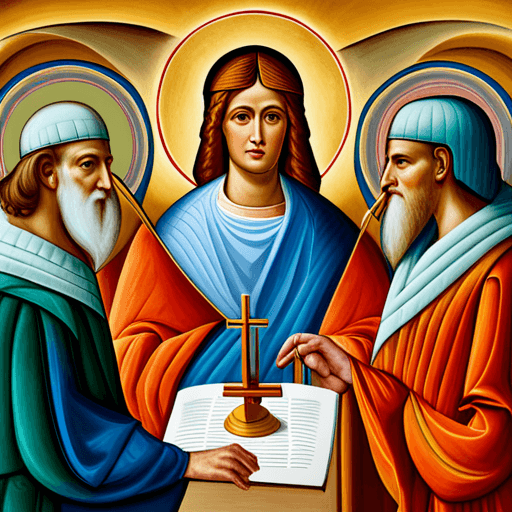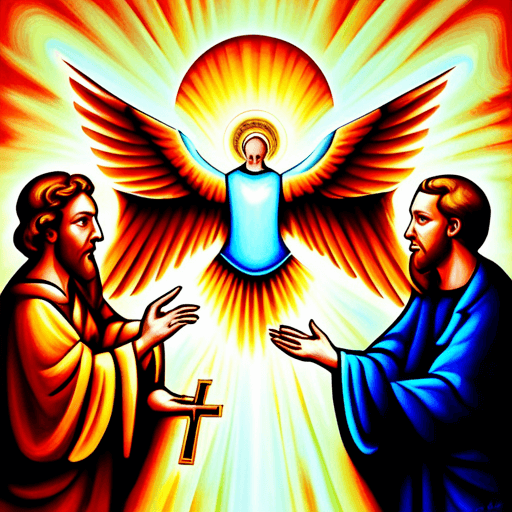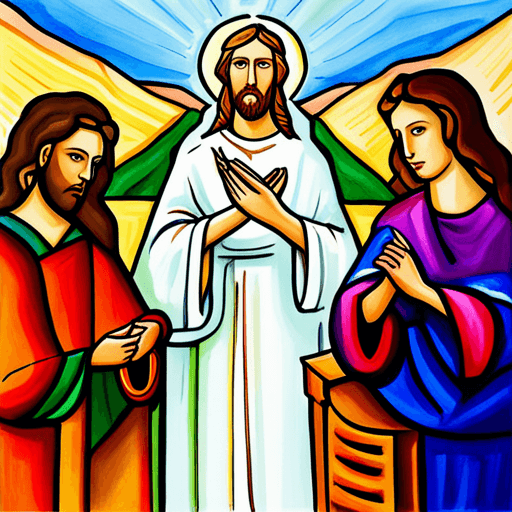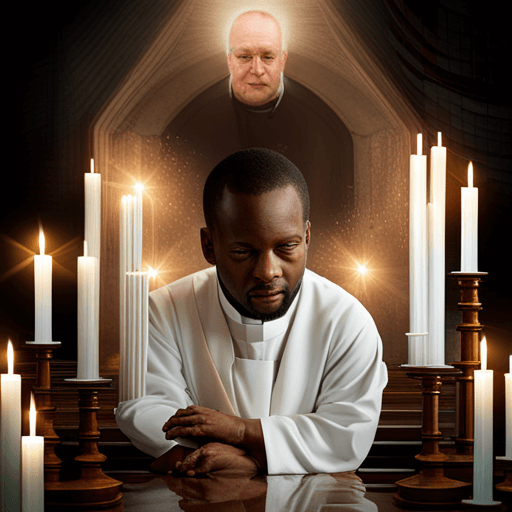You, dear reader, are part of a long and rich history of Christian belief. As you sit in your church pew or read this article on your screen, you are connected to generations of believers who have grappled with the same questions and mysteries that you do.
One of the most profound and enduring mysteries is that of the Trinity – how can God be three persons in one? Trinitarian theology has been debated, refined, and defended throughout Christian history. From its roots in the New Testament to the Councils of Nicaea and beyond, theologians have sought to understand and articulate this central tenet of faith.
In this article, we will explore the development of Trinitarian theology in early church history – from the wrestling with implications by the Apostolic Fathers to defining key terms such as Homoousios and Hypostasis by Tertullian, Origen, and Athanasius. Alongside these insights into theological thought processes will be an analysis of responses to challenges like heresies that threatened orthodox Christian belief.
Through it all runs a thread connecting us to our spiritual ancestors as we seek understanding for one another and ourselves.
Tracing the Roots of Trinitarian Theology in the New Testament
You’re about to dive into the origins of how Christians in the past understood the nature of God, as revealed in the New Testament. Tracing back to its Jewish roots, early Christian thought was influenced by Greco Roman philosophy as well.
The idea of a triune God emerged slowly and developed over time from implicit to explicit Trinitarian doctrine. Although the word ‘Trinity’ is not found in the New Testament, there are several passages that imply it.
One example is Matthew 28:19, where Jesus instructs his disciples to baptize ‘in the name of the Father and of the Son and of Holy Spirit.’ This passage suggests a distinction between three persons who share one divine essence.
As Christianity spread throughout different cultures, it was inevitable for these ideas to be influenced by other philosophical traditions. Nonetheless, tracing back through history allows us to understand how this central doctrine evolved over time.
Wrestling with the Implications of Divinity: The Apostolic Fathers and the Apologists
As the Apostolic Fathers and Apologists grappled with the implications of divinity, they were forced to confront complex questions about the nature of God and his relationship to humanity. Early interpretations of Christology debates led to philosophical influences that ultimately shaped theological developments in the early church.
These thinkers sought to understand how Jesus could be both fully human and fully divine, while also reconciling this belief with the traditional Jewish understanding of monotheism. Philosophical influences such as Platonism and Stoicism were integrated into early Christian thought as theologians attempted to reconcile their beliefs with Greek philosophy.
This led to a more nuanced understanding of the Trinity, where each person was seen as distinct but unified in substance. The development of these ideas would continue throughout church history, shaping our understanding of God even today.
As we look back on these early debates, we can see how they laid the groundwork for centuries of theological reflection and exploration.
Defining Key Terms: Homoousios, Hypostasis, and Ousia
Let’s dive into some of the essential concepts that shaped our understanding of God and his relationship with humanity, including Homoousios, Hypostasis, and Ousia. These terms were not only crucial in defining the nature of the Trinity but also had significant philosophical implications.
The term Homoousios, meaning ‘of the same substance,’ was used to affirm that Jesus Christ was fully divine and co-equal with God the Father. This concept sparked theological controversies as it challenged traditional beliefs about monotheism.
Moreover, Hypostasis or ‘person’ referred to distinct individuals within the Trinity who share one essence. It helped to explain how three persons could be unified in one Godhead without compromising their individuality.
Lastly, Ousia or ‘essence’ represented a fundamental aspect of being for both God and human beings. It was through these debates that early theologians sought to articulate their understanding of God’s nature while grappling with complex philosophical ideas such as substance and personhood.
In conclusion, these terms played a vital role in shaping trinitarian theology during this period and continue to influence Christian thought today.
Refining the Doctrine: Tertullian, Origen, and Athanasius
Now we delve into the minds of Tertullian, Origen, and Athanasius as they refine our understanding of the divine nature and its relationship with humanity.
These early church fathers were pivotal in shaping the doctrine of the Trinity that’s still widely accepted today. They grappled with trinitarian controversies and theological differences that threatened to divide the church.
Tertullian was one of the first to use the term ‘Trinity’ to describe God’s triune nature. He emphasized that each person of the Trinity was distinct yet united in essence or substance.
Origen, on the other hand, believed that Christ was subordinate to God the Father and not equal in status. This view sparked controversy among his contemporaries and led to accusations of heresy.
Athanasius defended the orthodox view that Christ was fully divine and co-equal with God. His tireless efforts helped pave the way for future councils to affirm this position.
Through their contributions, Tertullian, Origen, and Athanasius helped refine our understanding of how God exists as three persons in one divine nature.
Responding to Challenges: Heresies and Orthodox Christian Belief
You may find it challenging to navigate the varying beliefs about the divine nature and its relationship with humanity, as there have been numerous heresies throughout Christian history that deviate from orthodox Christian belief.
One of the earliest theological controversies was around modalism, which denied the Trinity and claimed that God existed in different modes or forms. This challenged orthodox Christian belief that God was three distinct persons – Father, Son, and Holy Spirit – who are equal in power and glory.
Another challenge came from Arianism, which denied Christ’s divinity by claiming he was a created being rather than co-eternal with the Father. This led to a significant debate within early Christianity about whether Jesus was fully human and fully divine, or just one or the other.
The Council of Nicaea eventually affirmed Christ’s divinity as an essential part of orthodox Christian belief, while also clarifying the relationship between Father and Son within the Trinity. These historical backgrounds give us insight into how these theological controversies shaped early Christian thought on trinitarian theology.
Frequently Asked Questions
How did the concept of the Trinity develop outside of the early Christian church?
You may be surprised to learn that the concept of the Trinity was not universally accepted outside of the early Christian church. In fact, there were many debates and theological disagreements that took place in various councils throughout history.
Some believed in a strict monotheism, while others saw Jesus as a separate entity from God. These discussions continued for centuries, with some even resulting in violence and persecution.
It wasn’t until much later that the idea of the Trinity became widely accepted among Christians. Despite these differences, one thing remains clear: our desire for belonging and understanding is universal, whether it’s through a belief in one God or three persons in one divine essence.
What role did politics play in the development and acceptance of the doctrine of the Trinity?
Did you know that politics played a significant role in the development and acceptance of the doctrine of the Trinity?
The political influence on Trinitarian theology can be traced back to the Ecumenical Councils, which were gatherings of bishops from all over Christendom. These councils were often convened by emperors, who sought to bring unity to their empire through religion.
It was at these councils that debates about the nature of God took place, and eventually led to the formulation of the doctrine of the Trinity. While theological arguments were certainly important, it was ultimately politics that helped shape and solidify this doctrine as a core tenet of Christianity.
How did different cultures and languages influence the understanding and interpretation of the Trinity?
As you delve into the concept of the trinity, you may realize that cross-cultural interpretation and linguistic nuances play a significant role in shaping its understanding. Different cultures have their unique way of explaining complex ideas, and language can influence how we perceive those explanations.
For instance, some languages may not have a word for ‘trinity,’ making it challenging to translate the idea accurately. Moreover, cultures that emphasize community over individualism might interpret the trinity differently from those who value individualism more.
Therefore, when studying the trinity’s history and development, it’s crucial to consider how different cultures and languages influenced its interpretation throughout time.
What impact did the development of the Trinity have on Christian art and iconography?
When it comes to Christian art symbolism, few things have had as profound an impact as Trinitarian iconography. Through the use of visual cues and artistic techniques, early Christian artists were able to convey their understanding of the Holy Trinity in a way that was both beautiful and meaningful.
From depictions of the Father, Son, and Holy Spirit as three distinct but united entities to images of the entire Trinity represented by a single figure with three faces or heads, Trinitarian iconography has played a significant role in shaping our collective understanding of this central tenet of Christianity.
Whether you’re a devout believer or simply someone with an interest in religious history and culture, exploring the world of Christian art can be a fascinating and enriching experience.
How has the doctrine of the Trinity evolved and been interpreted throughout different periods of church history?
You may have heard of the Trinitarian controversies that rocked the early church, but did you know that the doctrine of the Trinity has continued to evolve and be interpreted throughout different periods of church history?
Theological implications abound as scholars grapple with questions about God’s nature and how Jesus fits into the equation. Some argue for a more hierarchical understanding, while others emphasize a more egalitarian approach.
Regardless of where you fall on this spectrum, one thing is certain: the doctrine of the Trinity remains a central focus of Christian theology, shaping our understanding of who God is and how we relate to Him.
Conclusion
You’ve just finished reading about the development of Trinitarian theology in early Church history. From tracing its roots in the New Testament to refining the doctrine through key figures like Tertullian, Origen, and Athanasius, you’ve gained a deeper understanding of how this complex theological concept came to be.
As you reflect on what you’ve learned, consider the challenges that early Christians faced as they grappled with the implications of divinity and sought to define key terms like Homoousios, Hypostasis, and Ousia. And yet despite these challenges and even in the face of heresies that threatened to undermine their beliefs, orthodox Christian belief ultimately prevailed.
In many ways, this journey towards understanding Trinitarian theology is a reflection of our own spiritual journeys – grappling with complex ideas and seeking clarity amidst confusion. But just as early Christians were able to hold fast to their beliefs despite adversity, we too can find strength in our faith as we navigate life’s challenges.




